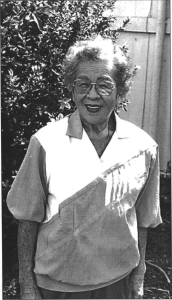Fusae Takaki

Tsunamis Remembered: Oral Histories of Survivors and Observers in Hawai‘i
Life history interviews with individuals who witnessed and survived tsunamis-particularly the 1946 and 1960 disasters on the Big Island of Hawai'i. Thirty individuals-mostly residents of Hilo and Laupahoehoe-recall their experiences before; during, and after the 1946 and 1960 tsunamis which were arguably the most destructive natural disasters in modem Hawaiian history.
Fusae Tanaka Takaki was born May 28, 1923 in Hilo. She was the youngest of four children born to Eijiro Tanaka and Kura Hano Tanaka, both immigrants from Fukuoka Prefecture, Japan. Eijiro Tanaka worked as a stone crusher, stevedore, and merchant marine. Her mother sold lunches and snacks from her car near Coconut Island and the Hilo wharf area. Takaki was raised in the Shinmachi district of Hilo, home to a large portion of Hilo's Japanese population. She remembers the many games she played with neighborhood children, movies, and helping her mother in the family garden located across the Wailoa River and accessible only by rowboat Her mother sold vegetables to neighbors and stores. Takaki attended Waiakea Kai Elementary, Hilo Intermediate, and Hilo High schools. She was forced to drop out after her sophomore year to help her parents make ends meet. She began working as an assistant to Dr. Sadaichi Kasamoto and remained there until 1980. Tragically, both Takaki's parents, a niece, and a nephew were killed in the 1946 tsunami. The family home as well as its entire contents were destroyed. Takaki and her mother held onto the bed as the wave came, but she eventually lost her grip. She was swept away from the house and engulfed in water, but managed to swim to safety. Takaki, who married Mitsuo Takaki three months after the tsunami, was provided housing in former U.S. Army barracks located in what is today Ho'olulu Park. The Takakis, who raised two daughters, lived in the housing for approximately four years. The oral history interview was conducted in her Hilo home that she has lived in since 1960.
Scope and Content Note
Shinmachi-born woman recalls her parents, neighborhood, home, and family life. Recounts harrowing tale of being caught in the tidal wave and the loss of her parents, niece, and nephew. She remembers helping at a doctor's office in the immediate aftermath of the tsunami. Also covers life after the disaster.
Program Note:
This interview is part of the Center for Oral History's project Tsunamis Remembered: Oral Histories of Survivors and Observers in Hawai‘i. Interviews from this project are available in the Center's ScholarSpace open access repository.
The Center for Oral History (COH), in the Department of Ethnic Studies at the University of Hawaiʻi at Mānoa, collects, documents, preserves and highlights the recollections of Native Hawaiians and the multi-ethnic people of Hawaiʻi. It produces oral histories and interpretive historical materials about lifeways, key historic events, social movements and Hawaiʻi’s role in the globalizing world, for the widest possible use.
Please Note: The oral histories in this collection are protected by copyright and have been created for educational, research and personal use as described by the Fair Use Doctrine in the U.S. Copyright law. Please reach out Voices@noaa.gov to let us know how these interviews are being used in your research, project, exhibit, etc. The Voices staff can help provide other useful resources related to your inquiry.
The NOAA mission is to understand and predict changes in climate, weather, oceans, and coasts, to share that knowledge and information with others, and to conserve and manage coastal and marine ecosystems and resources. The Voices Oral History Archives offers public access to a wide range of accounts, including historical materials that are products of their particular times, and may contain offensive language or negative stereotypes.
Voices Oral History Archives does not verify the accuracy of materials submitted to us. The opinions expressed in the interviews are those of the interviewee only. The interviews here have been made available to the public only after the interviewer has confirmed that they have obtained consent.
